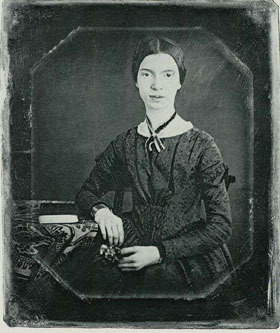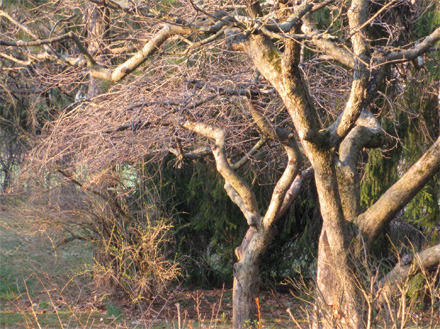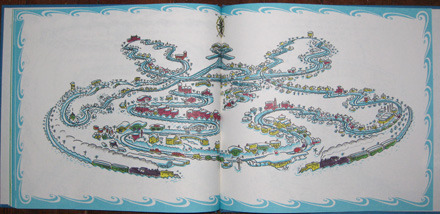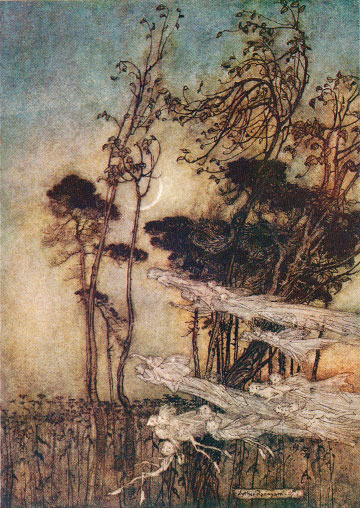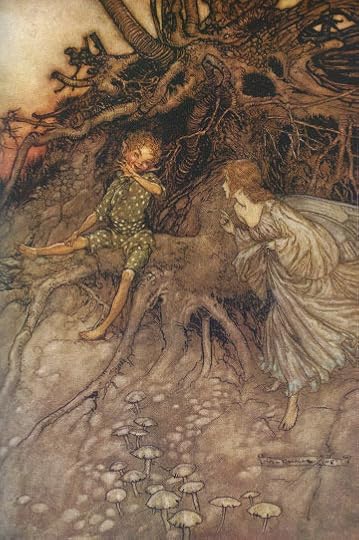John Lechner's Blog, page 5
June 5, 2011
I dreaded that first Robin
Today I'd like to share a poem by Emily Dickinson, one of her many works inspired by nature. Despite the pleasant imagery of birds and daffodils, it's really a melancholy poem, describing how even the most beautiful things can be painful when you're feeling sad. And the more beloved they are (the poet clearly loves the garden in springtime) the more piercing it is to look upon them.
Like all great poems, this one has been interpreted many different ways by different people. What do you think it means?
* * *
I dreaded that first Robin, so,
But He is mastered, now,
I'm some accustomed to Him grown,
He hurts a little, though —
I thought if I could only live
Till that first Shout got by —
Not all Pianos in the Woods
Had power to mangle me —
I dared not meet the Daffodils —
For fear their Yellow Gown
Would pierce me with a fashion
So foreign to my own —
I wished the Grass would hurry —
So — when 'twas time to see —
He'd be too tall, the tallest one
Could stretch — to look at me —
I could not bear the Bees should come,
I wished they'd stay away
In those dim countries where they go,
What word had they, for me?
They're here, though; not a creature failed —
No Blossom stayed away
In gentle deference to me —
The Queen of Calvary —
Each one salutes me, as he goes,
And I, my childish Plumes,
Lift, in bereaved acknowledgment
Of their unthinking Drums —
* * *
May 10, 2011
Writing books and pruning trees
Spring is here, and that means gardening season. The parallels between writing and gardening are many, and have been appreciated by writers for generations – planting a seed, nurturing the sprouts, weeding out what is unnecessary, watching it blossom, etc.
A few weeks ago, I set out to prune an apple tree and was confronted by a massive maze of branches. The spindly sticks overlapped in all directions, making it nearly impossible to see which branches constituted the main structure of the tree, the ones that formed the backbone and needed room to grow.
I could not think how to begin, but I did notice one branch that obviously needed to go. It twisted up against another branch so that they seemed to be wrestling to the death. So I picked up the shears and lopped it off, and it came down with all its spindly branches like a giant urchin.
As soon as this branch was gone, my view of the tree became much clearer, I could see the main shape as it should be, and noticed other branches that could be taken away. With each branch I cut, the true nature of the tree became clearer.
So it is with editing a manuscript, sometimes just taking away one piece will allow you to see the rest with more clarity. And pruning a manuscript has one distinct advantage over pruning a tree – if you change your mind, you can always put the words back.
April 3, 2011
Happy Spring!
* * * * *

Antonio Vivaldi
Spring is sprung, even though the weather is still a bit uncooperative. To celebrate the new season, here is a creative interpretation of Vivaldi's "Spring" violin concerto. The ensemble is called Red Priest, named after Antonio Vivaldi himself, who was nicknamed "The Red Priest" because of his flaming red hair (and he was also a priest.) I'm sure you've heard Vivaldi's Four Seasons before, but probably not like this.
Originally written for string ensemble, Vivaldi intentionally wrote the parts to sound like birds, streams, and rainstorms. He based the concertos on a series of sonnets, which are believed to be written by Vivaldi himself. Below is the section that describes the movement played in the video above, translated from the Italian:
Springtime is upon us.
The birds celebrate her return with festive song,
and murmuring streams are softly caressed by the breezes.
Thunderstorms, those heralds of Spring, roar, casting their dark mantle over heaven,
Then they die away to silence, and the birds take up their charming songs once more
You can hear all of these things in Vivaldi's music, especially in this lively and inventive performance by Red Priest ensemble, consisting of violin, recorder, cello and harpsichord. (The next time your child doesn't want to practice the recorder, show them what the amazing Piers Adams can do with the instrument!)
Hope you enjoy this stormy, sunny, chilly, unpredictable spring!
* * * * *
March 18, 2011
A tree for all seasons
[image error]
When people think of looking at trees, March is not usually the month that comes to mind. At least in the northern climates, March is a month when the world seems colorless, trees are bare, and the ground is either frozen or soggy. We are exhausted from winter and just want to see spring.
But I think winter trees, stripped of all their leaves, can be really amazing to look at. You can see all the twisting branches, the intricate patterns. Light falls differently in the winter, weather changes often, and nearly every day creates a different view.
A Swedish photographer named Stefan Jansson photographed the same tree every week for a year, to observe how it changed. The results are truly remarkable, as you can see the tree as it passes through variations that most of us don't even notice. Look through the slideshow above or view his whole set of photos on Flickr to see the amazing variety from this one tree.
So don't wait until autumn – trees can be appreciated all year long, if you just take the time to look.
February 4, 2011
Katy and the Big Snow – a children's classic
All this recent snow has reminded me of one of my favorite picture books from childhood, Katy and the Big Snow by Virginia Lee Burton. Though not as famous as some of her other books, I think it's one of the best books about snow, and one of the best picture books ever made.
The story is deceptively simple – a city is buried in a blizzard of snow, and a tractor named Katy saves the day by plowing everyone out. But there are many remarkable things about this book, starting with the design. Burton was a designer and printmaker as well as an author and illustrator, and she uses pattern, shape and simplification to turn every page into a visual marvel. Take the city itself, designed as a map so intricate yet so understandable because of its simple design.
This map becomes even more amazing when you realize that it is a template for all the scenes later in the book. When Katy plows out the railroad station, you can go back to the map and see how it matches up. Burton even adds a compass to many of the pages to help readers see where they are.
There is also a wonderful use of white space to emphasize the blanket of snow that envelopes the city. As the intrepid tractor plows through the snow, we see the city emerge from the whiteness. She plows each section of the city, eventually uncovering the entire map that we saw at the beginning of the book.
There are many other layers to this book, for instance how it shows all the different parts of a city (fire department, water department, telephone company, etc) and how they work together. And it has great little details like the milk truck and bakery truck resuming their deliveries after Katy clears the way.
The repeating swirls and curves of the city establish a visual theme that is carried throughout the book. Even more so than The Little House or Mike Mulligan, this book uses the kind of decorative borders and patterns that Burton excelled at in her printmaking and fabric design. The simple palette of white and blue, set off with highlights of red, yellow and green for the buildings, makes for a vivid and memorable design.
There are almost no close-ups in this book, something which goes against all the "rules" of book illustration that say you must vary your perspective. And yet it works here because it lets you follow Katy's progress as she plows out each section of the city, and you can see not only where she is at that moment, but also the places she previously plowed out as they resume their business. Burton had an instinctive eye for how to tell a story visually, and how to show only what was necessary.
The story itself contains themes of patience and hard work. Katy is too big to plow during light storms, but when the big blizzard hits, she comes to the rescue and saves the entire city. The fact that Katy is a female tractor is never mentioned, which in itself is a quiet but powerful message about equality. Almost sixty years after its publication, children's books about trucks and machines are still overwhelmingly aimed at boys, which is too bad. Katy was a pioneer, just like her creator, carving out new paths in storytelling and bookmaking. This is a true classic, far ahead of its time; and in some ways, ahead of ours.
January 2, 2011
The Winter's Wind – a poem by Keats
As the new year begins, I present for you a poem by John Keats, inspired by a cold winter's wind but encompassing so much more.
The image I've chosen to accompany the poem is a famous one by Casper David Friedrich called "The Wanderer Above the Mists", painted around 1817. Obviously the artist is captivated by the misty mountains, but then why place a person in the very center of the image, blocking our view? And we can't see his face, we can only wonder at who he is and what he is thinking. It's this kind of mystery, along with the expert composition and technique, that make the painting great. There's a bigger idea at work here, a puzzle that the viewer must unravel.
The poem is also open to interpretation, but I won't even try to analyze it. I'll let the poet speak for himself.

The Wanderer Above the Mists, by Casper David Friedrich
* * *
O thou whose face hath felt the Winter's wind,
Whose eye has seen the snow-clouds hung in mist,
And the black elm tops 'mong the freezing stars!
To thee the spring will be a harvest time.
O thou whose only book has been the light
Of supreme darkness, which thou feddest on
Night after night, when Phœbus was away!
To thee the spring shall be a triple morn.
O fret not after knowledge. I have none,
And yet my song comes native with the warmth.
O fret not after knowledge! I have none.
And yet the evening listens. He who saddens
At thought of idleness cannot be idle,
And he's awake who thinks himself asleep.
– John Keats (1795-1821)
* * *
December 15, 2010
The Snowman
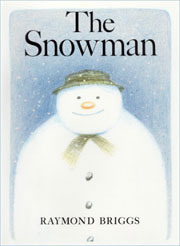 Winter is just about here, with snow already falling in colder climates. Winter can be harsh and brutal but also peaceful and stunningly beautiful. It's a season that inspires artists, writers and filmmakers. For the next couple months here at The Untended Garden, I will be focusing on art and storytelling that deals with snow and winter, starting with a modern classic.
Winter is just about here, with snow already falling in colder climates. Winter can be harsh and brutal but also peaceful and stunningly beautiful. It's a season that inspires artists, writers and filmmakers. For the next couple months here at The Untended Garden, I will be focusing on art and storytelling that deals with snow and winter, starting with a modern classic.
The Snowman is a wordless picture book written and illustrated by Raymond Briggs. It tells the tale of a boy who builds a snowman who comes to life one night. The snowman explores the boy's house with him and later takes the boy flying through the air. The magic of the book lies not only in the story, but the wordless images, arranged in a sequential, comic book style that lets you experience each scene moment by moment.
It's this visual storytelling that makes the book perfectly suited for animation, and in 1982 the book was turned into a film by British director Diane Jackson. This is that rare case where a film adaptation enhances the original story without losing the intent or charm of the original. In particular, the journey through the air is much more elaborate in the film, flying over cities and oceans to the polar regions and back, and the gorgeous music by Howard Blake perfectly sets the mood.
I'd like to call your attention to the animation itself, which is all drawn by hand. This film was made thirteen years before Toy Story revolutionized the animation industry. Today, 3D computer animation is king, and everyone marvels at the amazing feats it can accomplish. But computer animation is limited by computer models and logic, it has to obey certain rules. Hand-drawn animation is limited only by the artist's imagination. Notice in the film how the mountains shift perspective and seem to melt into each other – this is purely an artistic vision of a landscape in motion, and wouldn't work in a computer-animated film, yet it perfectly fits the magical impossibility of the story, and evokes a world where anything can happen.
It just goes to show, whether in books or films, a pencil is still often the most expressive tool of all.
November 11, 2010
Arthur Rackham's Midsummer Night's Dream
 November always puts me in the mind for Arthur Rackham, one of my favorite illustrators. I especially love how he draws trees, which are like living, breathing creatures with personalities all their own.
November always puts me in the mind for Arthur Rackham, one of my favorite illustrators. I especially love how he draws trees, which are like living, breathing creatures with personalities all their own.
With a limited palette and spare lines, his paintings are full of raw emotion, and he finds beauty in the most gnarled and thorny landscapes. His palette was mostly due to the limited color printing process at the time, though you can tell he's right at home with it, and can channel a thousand subtleties in its limited range.
These illustrations are all from A Midsummer Night's Dream by William Shakespeare. For a tale so entwined with nature and magical creatures, Rackham is the perfect fit. Notice how the characters and backgrounds are seamlessly blended together, so that the landscape becomes a character in itself. When not illustrating, Rackham did a lot of sketching landscapes outdoors, and it shows in his work. I encourage you to find books with his illustrations, to see all the amazing detail.
* * *
* * *
* * *
* * *
* * *
* * *
October 31, 2010
The Sibley Guide to Trees
 Autumn is a great time to look at trees, and a new tree guide was published last year by David Allen Sibley, best known for his bird books. The Sibley Guide to Trees is more than just an identification guide, it is a veritable encyclopedia covering over 600 kinds of trees found in North America. Best of all, the book doesn't use photographs, it uses illustrations, all painted by Sibley himself.
Autumn is a great time to look at trees, and a new tree guide was published last year by David Allen Sibley, best known for his bird books. The Sibley Guide to Trees is more than just an identification guide, it is a veritable encyclopedia covering over 600 kinds of trees found in North America. Best of all, the book doesn't use photographs, it uses illustrations, all painted by Sibley himself.
Why take the time to draw each tree and leaf rather than photograph it? As the author explains in the video below, an artist has the ability to create a more representative image by combining many examples, and can show the object in the best light for the viewer to see and understand. The artist can also emphasize certain details, making us see things in a new way.
Art and science were far more closely aligned years ago, in the days before cameras, when the only way to document the world was to draw it. But the benefits of drawing have not gone away. To draw something is to know it better, and a drawing can often teach us things about the world that a photograph cannot.

Sample page from The Sibley Guide to Trees
The illustrations by David Allen Sibley for his tree guide (as with his bird books) are accurate and precise, yet also have an artistic flair all their own. They capture the essence and texture of the natural world. And he doesn't just depict trees from a distance, but also shows the individual leaves, the bark, the seeds, the flowers, and whichever details are most pertinent to that tree. And the pages are large enough to let you really see the art. The text perfectly compliments and explains the pictures, and both work seamlessly together.
Below are some additional links to learn about the author and his work:
David Allen Sibley official website
The author's information about trees
An interview with the author about his tree book
Another interview with the author about his books
Finally, here is the author talking about how he created his tree guide, and why he prefers illustrations rather than photographs.
* * *
October 7, 2010
The untended garden
Vincent Van Gogh, "Landscape With Olive Trees"
What exactly is an untended garden? The phrase often has a negative connotation, like Shakespeare's "unweeded garden" overrun with foul things. We tend to think of nature as something that needs taming, otherwise it will take over and devour us.
But today in our shrinking world, it's more important for us to understand and get along with the flora and fauna around us, for we're all in this together – we need each other, whether we like it or not. If they die, we die, it's as simple as that.
The mission of this blog is to explore how artists, writers, musicians, filmmakers and designers explore nature in their work. And I don't mean simply how artists depict the beauty of nature, but how they plumb the depths and seek out its essence.
To draw something is to understand it better. Same with writing. I hope by highlighting artists with interesting and unique perspectives on nature, I can bring readers closer to the world around them, and inspire more artists to do the same. The world is an untended garden, but we must tend it carefully lest we kill it in the process.
John Lechner's Blog
- John Lechner's profile
- 18 followers


